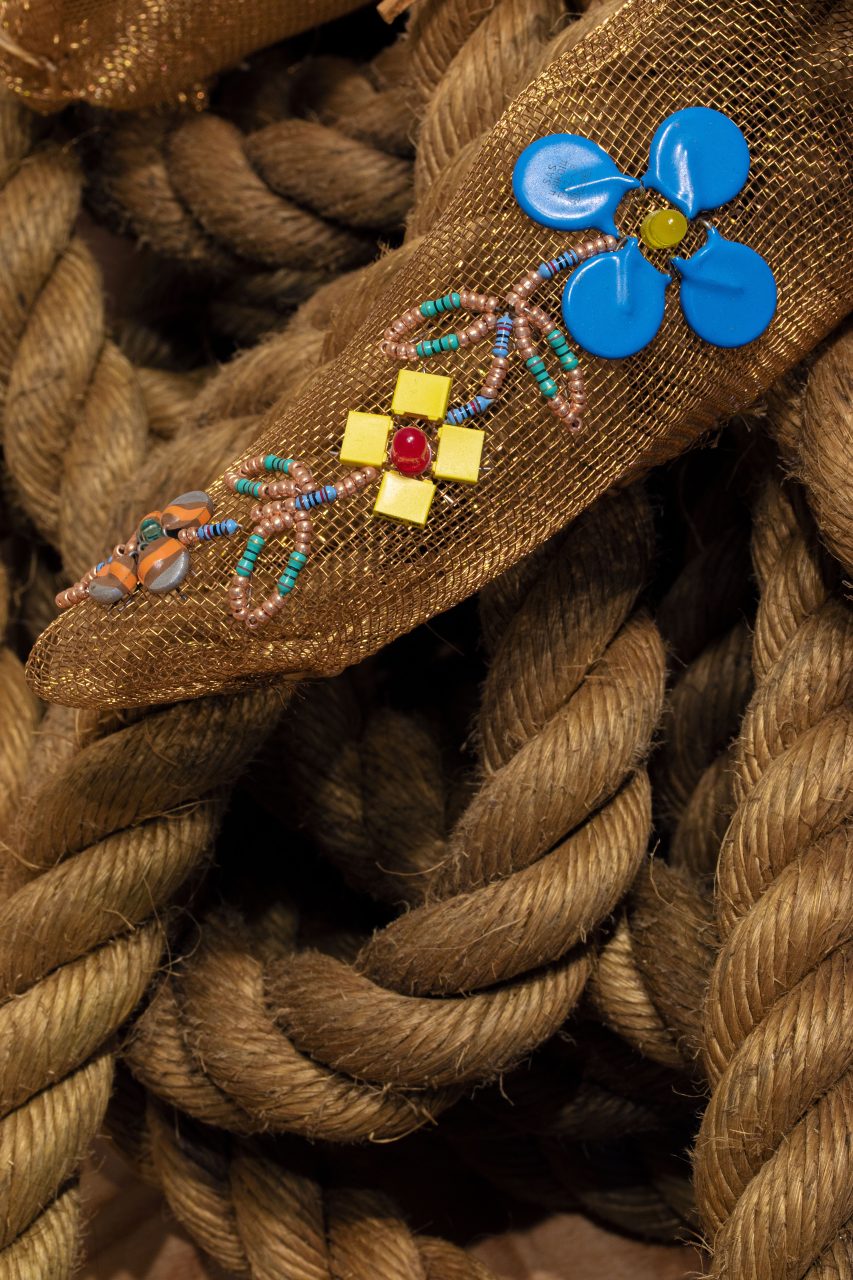To view photo images scroll right on laptop or down on Iphone
The McMichael Canadian Art Collection in Kleinburg, Ontario is the largest publicly funded art gallery in Canada that focuses exclusively on Canadian and Indigenous art, both historical and contemporary. The permanent collection consists of over 6,500 artworks by Tom Thomson, the Group of Seven, their contemporaries, and First Nations, Métis, Inuit and contemporary artists who have contributed to the development of the art of Canada.

How can you expect me to reconcile, when I know the truth? (2018),wood, hemp rope, metal, linen, organza, bronze screen, electroniccomponents, glass beads, deer hide, cotton thread, vinyl, 284.5 x 271.8 x 134.6 cm. McMichael Canadian Art Collection.
Essay by Leah Snyder
In How Can You Expect Me To Reconcile, When I Know The Truth? a work that grapples with the Canadian Indian residential school system, dry transfer letters spell out “debwewin.” The word, which means truth in Anishinaabemowin, is positioned slightly back from the installation, which is assembled from sourced antique apparatuses and materials, including what resembles a yoke, its lopsidedness connoting an unequal tethering. Barry Ace has added pulleys that could be viewed as “representing the scales of justice or injustice.” Thick nautical hemp rope runs the length from one side to the other descending into a pile on the right, on the left knotting around a small form. The concealed shape underneath the gauze is a cradleboard, a vessel used in many First Nations to carry babies and called a tikinagan in Anishinaabemowin.
The work was created during a residency for Ontario College of Art & Design University’s (OCADU ) Nigig Residency in January 2018, an initiative of the Indigenous Visual Culture Program at OCADU . It travelled to Stockholm, Sweden as part of the group exhibition PUBLIC DISTUR BANCE : Politics and Protest in Contemporary Indigenous Art from Canada. Curated by Ottawa’s Galerie SA W Gallery for the Supermarket 2018 Stockholm Independent Art fair, the location where the work was installed was in a slaughterhouse in Slakthusomr.det, the Meatpacking district of Stockholm. It was also exhibited as part of Art + Law Indigenous Artist in Residence Program, a partnership between the Arts Council Windsor & Region, the University of Windsor Faculty of Law and School of Creative Arts that coincided with the 2018 World Indigenous Law Conference—Waawiiatanong Ziibi: Where the River Bends, The Application of Indigenous Laws in Indigenous Communities and in the Courts.
In the most recent install, the face of the cloth vintage doll secured inside the tikinagan is revealed. Previously, the fabric hid the object entirely. Without looking closely, its presence. could be missed. For Ace, the work was a “presage” of the events of May 2021 when the Canadian media announced that the unmarked graves of 215 unnamed children were “discovered” by radar technology at Kamloops Indian Residential School. For Indigenous people, it was not a “discovering” but an “uncovering.”
On the piece of translucent and ghost-like organza that hangs over the doll’s head, Ace has printed archival images. As with much of Ace’s work there is a biographical underpinning. Printed on the fabric is an image taken by his grandmother of his great-aunt as a child. In her arms, she is holding his father as a baby. Other images include a hand drawn map and vintage photographs of St. Peter Claver School for boys and St. Joseph’s School for girls. Located in Spanish, Ontario, the two schools combined made up one of the largest Indian Residential Schools in Ontario. His great-aunt attended St. Joseph’s.
The hemp rope references the type used by the Garnier, a boat that towed a large open skip called the Red Bug. The skip transported the children from the reserve communities. on Manitoulin Island to the Spanish Residential Schools on the mainland. Suspended from the cordage, spilling out onto the floor, are mesh forms resembling children’s footwear, perhaps European in style or moccasins or both, hybrid apparel for navigating through disparate worlds. Some are covered with Ace’s signature embellishment of electronic resistors, capacitors and light-emitting diodes, referencing the traditional knowledge and culture that survived the forced assimilation that occurred at the schools. Others have no embellishment, rendered vacant and hollow to signify culture loss or death. The motifs represent medicinal flowers and plants to transmit what is required to restore spiritual balance. Attached as an appendage to the back bronze mesh forms are long deer hide fringes which transform the footwear into “traildusters” a type of moccasin that was worn with fur, like foxtail, extending from the ankle and heel. The function of the design implementation was to erase one’s tracks on a trail while being pursued by a potential enemy. The installation is moored on a piece of wooden floor, a material detail that recalls the Victorian era buildings that housed the Indigenous children. Uneven planks jut out on one end.
Ace’s continual circling back to previous aesthetic and design decisions is a way to revisit particular themes that shape his work from a slightly different perspective, building on prior iterations while incorporating uncovered information, whether from the archives or current issues. His practice is an examination of the legacy of historical trauma, countered with the questioning of what the strategies are that promote cultural continuity.
 McMichael Canadian Art Collection, Kleinburg, Ontario
McMichael Canadian Art Collection, Kleinburg, Ontario  How can you expect me to reconcile, when I know the truth? (2018),wood, hemp rope, metal, linen, organza, bronze screen, electroniccomponents, glass beads, deer hide, cotton thread, vinyl, 284.5 x 271.8 x 134.6 cm. McMichael Canadian Art Collection.
How can you expect me to reconcile, when I know the truth? (2018),wood, hemp rope, metal, linen, organza, bronze screen, electroniccomponents, glass beads, deer hide, cotton thread, vinyl, 284.5 x 271.8 x 134.6 cm. McMichael Canadian Art Collection.  How can you expect me to reconcile, when I know the truth? (detail).
How can you expect me to reconcile, when I know the truth? (detail).  How can you expect me to reconcile, when I know the truth? (detail).
How can you expect me to reconcile, when I know the truth? (detail).  How can you expect me to reconcile, when I know the truth? (detail).
How can you expect me to reconcile, when I know the truth? (detail).  How can you expect me to reconcile, when I know the truth? (detail).
How can you expect me to reconcile, when I know the truth? (detail).